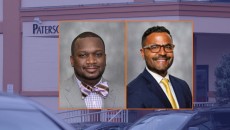The city contributed $41.5 million to the school district’s 2017-18 budget. However, that’s less than half of the $91 million local taxpayers should have contributed to educate their children, according to an estimate based on the school funding formula.
Local taxpayers underfunded the school district by $49.5 million, according to data from Newark-based Education Law Center. This combined with the state, which provided $401.4 million rather than the required $458.4 million, underfunded the district by a combined $106.5 million.
Business administrator Richard Matthews in a budget information session at a community forum last week highlighted both the local and state underfunding of the school district that has led to hundreds of layoffs over the years. He alluded to a possible tax increase in the 2018-19 school year budget.
“He’s probably correct in the way it’s calculated,” said school board member Flavio Rivera, chairman of the fiscal committee. “That doesn’t mean it [a tax increase above the 2-percent cap] should be contemplated.”
School board member Jonathan Hodges often complains about the state’s “illegal” underfunding of the school district. When asked if Paterson is paying its fair share to educate its children, Hodges pointed to the $25 million the state government provides to the municipal government to provide basic services.
“Paterson is a distressed entity. Unfortunately, it finds itself in an incredible bind,” said Hodges. “The municipal government at this time is incapable of providing that kind of money.” He said the state could have gradually increased the local school levy over the past years, but has failed to do so.
Hodges admitted “technically” local taxpayers are also underfunding their school system.
For the first time in the past decade, the state raised the local school levy in 2016-17 school year by $2.5 million or 6.5-percent. School board members opposed a second tax hike in the 2017-18 school year budget forcing former state-appointed district superintendent Donne Evans to back away from the tax hike.
Evans’ hike was hardly enough to get local taxpayers to contribute their “fair share” to the school district based on the School Funding Reform Act (SFRA) of 2008.
“The local fair share is determined by a calculation that determines each district’s ability to pay using two indicators of the districts capacity to raise revenue: aggregate personal income and equalized valuation – the market-rate value of property in the district,” explained Danielle Farrie, research director at the Education Law Center on Tuesday. “The formula determines an ‘adequacy budget’ for each district based on enrollment and student characteristics. State aid is calculated as the difference between the adequacy budget and the local fair share. The state then also provides full funding for some categorical aids – part of Special Education, Transportation, and Security Aid.”
Both personal income and the city’s tax base have shrunk in recent years. For example, the median family income dropped by a thousand-dollar from $33,964 in 2014 to $32,915 in 2015, according to latest U.S. Census estimates. The city’s tax base or equalized valuation, has declined from $8.2 billion to $6.35 billion, according to municipal records.
“We’re a struggling city. A lot of people struggle to just meet every day cost of living,” said Rivera. “I don’t think that Paterson taxpayers could absorb that amount of school levy.”
Newark and Jersey City
Paterson is not alone in not contributing its fair share to the school district.
Taxpayers in Jersey City paid a third of their “fair share” in 2017-18 school year. Under the school funding formula, Jersey City taxpayers should have paid $336 million, but only contributed $114.4 million.
Newark has done a better job in funding its school district. Under the funding formula, Newark taxpayers were required to pay $172 million. Homeowners contributed $123.2 million in the 2017-18 school year.
The state has fully funded the Jersey City school district since 2012. The state underfunding has been so severe in Paterson that lawmakers gave the school district an extra $4.3 million over the summer as part of a budget deal between Democrats and Republican Gov. Chris Christie.
“There is no mechanism that would allow the state to withhold aid even if the district is not raising it fair share,” said Farrie. “Over 120 districts are below their local fair share, but over 350 districts are below their proper state aid level.”
The local taxpayers in Paterson could face a possible double tax increase – both could be over the 2-percent cap — from the municipal government and the school district. The city has a $15.6 million budget shortfall. It’s still too early to know the shortfall at the school district.
Gov-elect Phil Murphy has promised to have “Paterson’s back” when he campaigned in the city. He has made repeated visits to Paterson while campaigning. He has promised to better fund the local school district.
Both school and municipal officials are hoping for more funding when Murphy takes office next month.
Email: [email protected]



